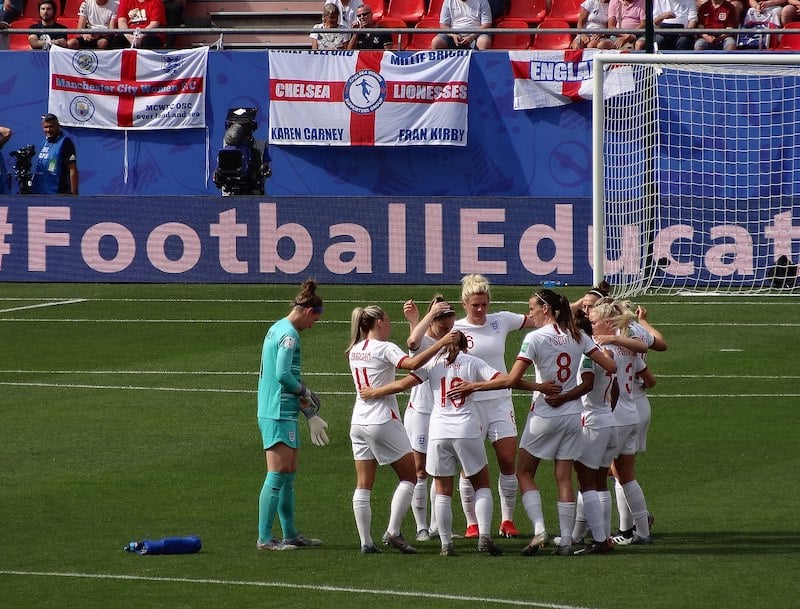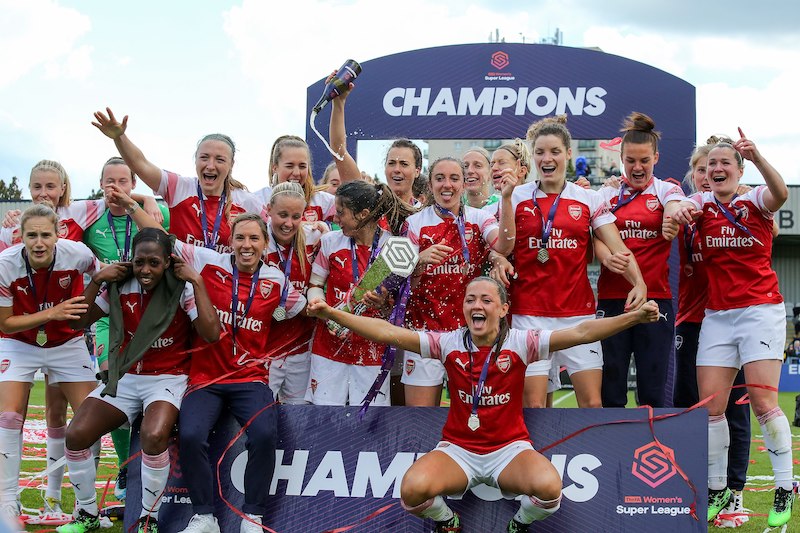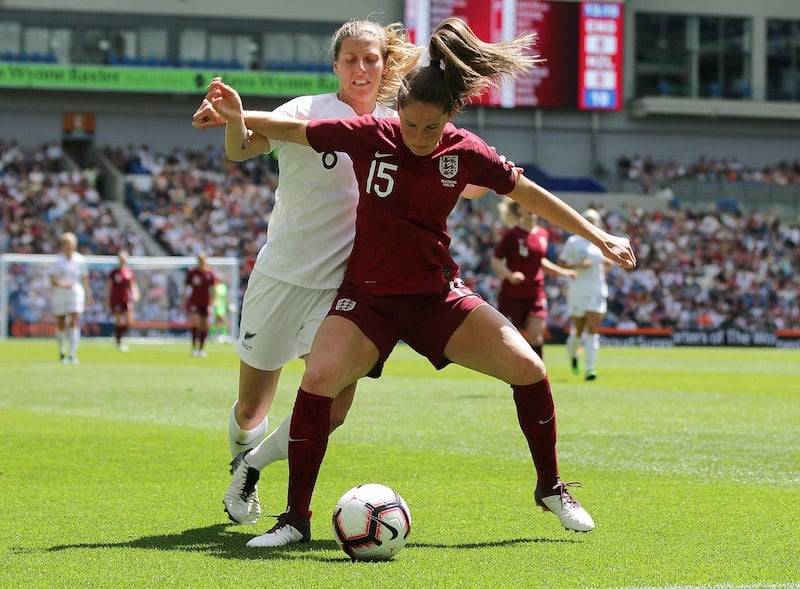On Sunday 31 July 2022, Chloe Kelly scored a 110th minute winner against Germany in the Women’s Euros final. This marked England’s first major football success since the 1966 World Cup.
Women’s football in England has enjoyed a surge in popularity in recent years, built around the success of the England Women’s team and the FA WSL.
After reaching the semi-finals of 3 major tournaments in a row from 2015-2019, the Lionesses finally won their first trophy in 2022. We’ll take a look at the remarkable rise of women’s football in England.
 Credit: Liondartois / CC BY-SA
Credit: Liondartois / CC BY-SA
History
The first known women’s football games in England took place during the 1880s and regularly drew in crowds in the thousands. The First World War led to the formation of over a hundred clubs as more women started working in factories and other sectors.
However, on 5 December 1921 the FA announced a landmark ruling that member clubs and grounds could not host women’s matches, as it was ‘unsuitable’ for women to play football.
Some clubs kept going and played their games at rugby grounds as part of the English Ladies’ Football Association, but much of the momentum had been lost.
Interest in football for women in England surged again after the men’s success in the 1966 World Cup, and the Women’s Football Association was established in 1969. The FA ban was finally overturned in 1971 meaning women’s teams could play at grounds around the country again.
England’s first international match was against Scotland in 1972, and they came back from 2-0 down for a 3-2 win against their northern rivals. England reached the final of the inaugural European Competition for Women’s Football in 1984, losing to Sweden on penalties.
The FA took over from the WFA in 1993 and England secured a place at the World Cup for the first time in 1995.
Hope Powell started her 15-year reign as the first full time head coach in 1998. The early 2000s were less successful but fortunes improved towards the end of the decade. England qualified for the World Cup again in 2007 for the first time in 12 years and reached the quarter-finals where they lost to the USA.
Central contracts were introduced in 2009 allowing some players to focus on training, with a £16,000 salary for 17 England women. Later on in 2009, England reached the final of the European Championships where they lost 6-2 to Germany.
The Lionesses reached the quarter-finals of the 2011 World Cup but failed to get out of the group in the 2013 Euros, leading to Hope Powell stepping down from her role.
Welshman Mark Sampson took over as England manager in 2013 and oversaw semi-final appearances in the 2015 World Cup and the 2017 Euros. He was replaced by Phil Neville in his first high-profile managing job.
2019 proved to be a remarkable year at international level as England beat Japan 3-0 to lift the SheBelieves Cup for the first time. That same year, England finished fourth in the Women’s World Cup in France with the semi-final defeat to the USA netting a TV audience of 11.7m viewers on BBC One.
Allied with results on the pitch was the snowballing support in terms of attendance figures. In November 2019, a crowd of 77,768 watched England play Germany at Wembley. This was a record for a Lionesses match and just shy of the international record (80,023) that was the 2012 Olympics final.
The international momentum kept women’s football in the spotlight despite coronavirus impacting all sport in 2020.
Sarina Wiegman took over as head coach of England Women from September 2021. The former Netherlands head coach was a high-profile, recent international footballer taking the helm from Phil Neville.
The 2022 Euros were held in England, postponed from 2021 due to the lingering effects of the coronavirus pandemic. England stormed to the final of the record-breaking home tournament and beat Germany 2-1 after extra time.
The tournament total attendance was 574,875 - more than double the previous record. 87,192 fans watched the final at Wembley - a record for any European Championship game, men’s or women’s.
England Women: profile and social media
As a broad indicator of interest in the women’s game, social media numbers suggest support is skyrocketing. More people than ever before are following the exploits of the England women’s football team.
1.8m people follow Alex Scott on Instagram, the ex-England and Arsenal defender who is now a pundit for the BBC and Sky. Women’s soccer in the USA is on another level with American player Alex Morgan boasting a whopping 9.6m Instagram followers!
For those professionals who embrace social media, there is possible commercial value but also a significant mouthpiece to alter opinion and promote the game.
FA WSL - Women’s Super League
Established in 2010, the FA Women’s Super League is the top level of the domestic game in England and sees 12 clubs battle it out annually from September to May.
The current champions are Chelsea who won their record fifth title in the 2021-22 season. (Photo of Arsenal lifting the trophy in 2019).

In November 2019, a Women’s Super League North London derby between Arsenal Women & Tottenham Hotspur Women enjoyed a league-record crowd of 38,262. In 2022, the Women’s FA Cup Final had 49,094 fans watch Chelsea beat Manchester City 3-2 at Wembley.
All of these figures emphasise the upward trend in popularity, fanned further by increased sponsorship and media coverage.
Barclays agreed a multi-million-pound sponsorship deal with the FA WSL in 2019 with a renewed effort to help boost involvement at grassroots level. This includes the FA Girls’ Football School Partnerships, a scheme designed to support girls’ access to football at school.
In 2021, the WSL signed a landmark broadcast deal with Sky and the BBC worth up to £24m over 3 seasons.
Here are the fixtures for the 2022-23 FA WSL season.
Women’s and girls’ football - participation
According to Football Association (FA) data from 2020, 3.4m women and girls in England now play football. This confirmed the FA had reached its target to double participation in 3 years.
As with all global tournaments, the figures are likely to spike after the home success in 2022. Though men’s football is more popular by some margin, the women’s game continues to show impressive momentum in all areas.
Girls under the age of 16 are flocking to take part with hubs such as 1,200 SSE Wildcats centres offering chances to have fun and play in a girls-only environment.
As a result, more than 34,000 girls have played football for the first time and as we’ve seen with other national efforts like cricket’s All Stars programme, it’s important to introduce sport at a young age.
There is always more to do and the FA’s head of women's football development, Louise Gear has said: ‘Attention now turns to the future, and we’ll be increasing our influence in schools, colleges and universities with national partners, Youth Sport Trust, Association of Colleges and BUCS (British university sport).’
 Credit: James Boyes from UK / CC BY
Credit: James Boyes from UK / CC BY
What’s next for women’s football in England?
After becoming European champions, attention now turns to the Women’s World Cup taking place in Australia and New Zealand in 2023. There is the possibility of a meeting with the number 1 ranked team in the world, the USA.
The Lionesses have signed an open letter to the Prime Minister asking for support to get more girls involved in football at schools.
There is hope the 2021 Euros triumph will create a legacy and inspire the next generation of girls and young women to start playing football.
Plenty to look forward to and if the grassroots momentum continues, allied with success at the top, there could be more good news stories to follow.
Why not check out some of our other blog posts?
What qualifications do I need to be a football coach?
How fit are Premier League footballers?
